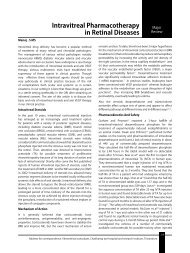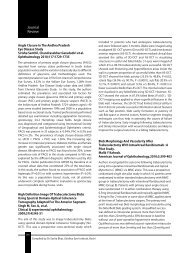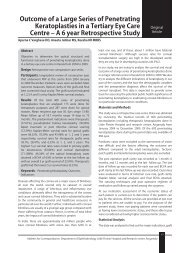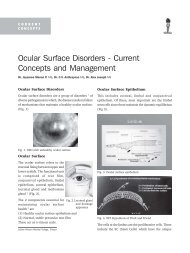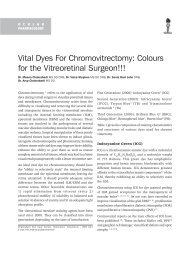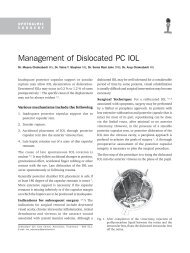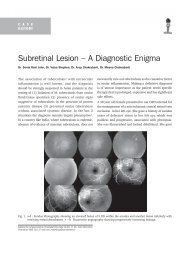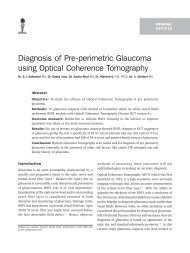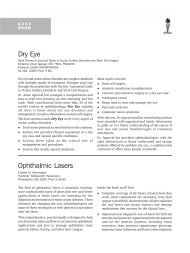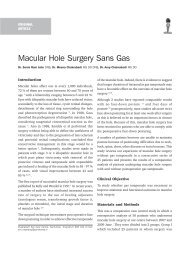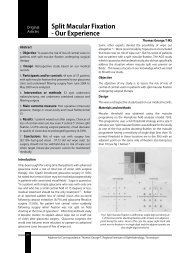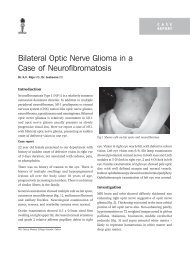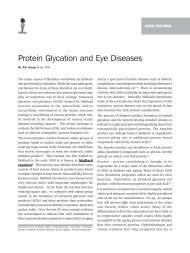Artificial Human vision - KSOS
Artificial Human vision - KSOS
Artificial Human vision - KSOS
Create successful ePaper yourself
Turn your PDF publications into a flip-book with our unique Google optimized e-Paper software.
426 Kerala Journal of Ophthalmology Vol. XXI, No. 4<br />
out with a new generation device having 49 electrodes.<br />
This trial named as the ‘Europe trial’ is going on in<br />
different universities in Europe including Hamburg,<br />
Parris, Austria, London. Reports of the out come can<br />
be expected by early next year.<br />
The project named EPI RET3 of Prof Walter et al. at<br />
University of Aachen reported results of a 25-electrode<br />
epiretinal array implanted for 4 weeks in 6 blind<br />
subjects 26 (Fig. 4).<br />
Fig.4. Camera chip embedded in goggle, epiretinal chip in<br />
position with stimulator in the posterior chamber.<br />
(image courtesy,IMI, Dr Hornig.)<br />
(ii) Subretinal Prostheses<br />
In the subretinal approach a micro photodiode array is<br />
implanted between the bipolar cell layer and the retinal<br />
pigment epithelium, either through an abexterno<br />
(scleral incision) or abinterno approach (through the<br />
vitreous cavity and retina).<br />
This was first described by Alan and Vincent Chow of<br />
Optobionics Corp, who believed that a subretinal<br />
implant could function as a simple solar cell without<br />
the need for a power or input source of any type 27,28,29 .<br />
Their <strong>Artificial</strong> Silicon Retina (ASR) Microchip is<br />
powered entirely by light entering the eye, without<br />
batteries or other ancillary devices. Two millimeters in<br />
diameter, the ASR contained approximately 5000<br />
microelectrode-tipped micro photodiodes which<br />
convert incident light into electrical signals similar to<br />
those normally produced by the retina’s own<br />
photoreceptors. These electrical impulses, in turn,<br />
stimulate any viable retinal neurons, which then process<br />
and send these signals to the visual processing centers<br />
in the brain via the optic nerve.This chip was implanted<br />
in 6 patients, with a follow-up of 6 to 18 months and<br />
reported gains in visual function in all patients as well<br />
as unexpected improvements in retinal areas distal to<br />
the implantation site. They hypothesized this as an<br />
effect due to the neuro modulation of the existing<br />
neurons due to the electrical activation.<br />
But later works demonstrated that the idea behind this<br />
simple approach is not feasible because it lacks a source<br />
of viable power 30 . Gabel et al showed that cortical<br />
activation secondary to retinal stimulation with such a<br />
device required brightness comparable to 2 to 3 times<br />
sunlight levels (energy) 31 . Simple photodiodes will also<br />
not produce charge balanced pulses, which are the<br />
safest form of electrical stimulation of nerve tissue. 32<br />
Across time, pulses that are not charge balanced will<br />
lead to dissolution of metal with toxicity to neural tissue<br />
and loss of electrode function. Methods to amplify these<br />
signals and produce charge balanced pulses are<br />
proposed but these add significantcomplexity 31 .<br />
In fact, Chow et al too have abandoned the notion that<br />
their ASR Microchip is efficacious as a prosthetic device<br />
and later thought that the low levels of current delivered<br />
from the implant, although insufficient to electrically<br />
activate any remaining retinal neurons in a retina with<br />
damaged photoreceptors, may act as therapeutic as well<br />
as neuro protective to otherwise dying retinal<br />
photoreceptors. Hence, it is thought that this type of<br />
an implant works through a “growth factor” that then<br />
rescues the remaining photoreceptors. Thus, some of<br />
the researchers claimed that this device is not a true<br />
retinal prosthesis but should be best classified as a<br />
therapeutic device.Studies by Pardue et al were on to<br />
determine whether these effects are indeed neuro<br />
protective as well as if they are persisting and<br />
reproducible 33, 34 . In addition, studies are also ongoing<br />
to determine whether an electronically inactive implant<br />
can have similar effects.<br />
In Germany another design for a subretinal implant<br />
has been under development since 1996 by a<br />
consortium of research universities under the guidance<br />
of Eberhart Zrenner. They have demonstrated in various<br />
animal models with comparable retinal degenerations<br />
that subretinal stimulation elicits neuronal activity in<br />
retinal ganglion cells. Also they were successful in<br />
defining parameters necessary for successful electric<br />
stimulation and then incorporated these data into the<br />
development of their photodiode arrays 35,36 .<br />
Having identified that the subretinal approach to a<br />
retinal prosthesis is not practical without an additional



